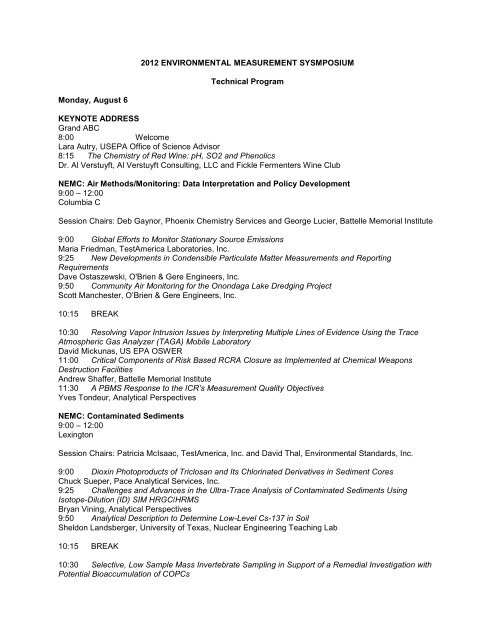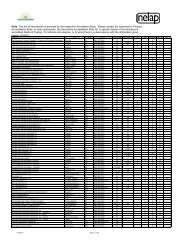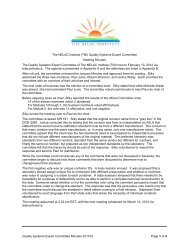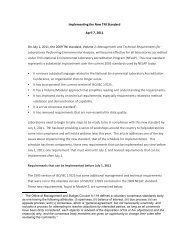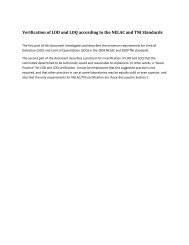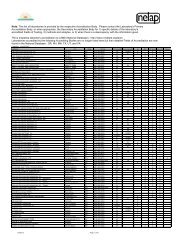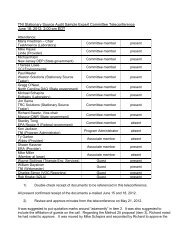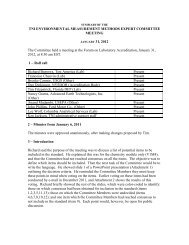2012 ENVIRONMENTAL MEASUREMENT SYSMPOSIUM ...
2012 ENVIRONMENTAL MEASUREMENT SYSMPOSIUM ...
2012 ENVIRONMENTAL MEASUREMENT SYSMPOSIUM ...
You also want an ePaper? Increase the reach of your titles
YUMPU automatically turns print PDFs into web optimized ePapers that Google loves.
Monday, August 6<br />
<strong>2012</strong> <strong>ENVIRONMENTAL</strong> <strong>MEASUREMENT</strong> <strong>SYSMPOSIUM</strong><br />
Technical Program<br />
KEYNOTE ADDRESS<br />
Grand ABC<br />
8:00 Welcome<br />
Lara Autry, USEPA Office of Science Advisor<br />
8:15 The Chemistry of Red Wine: pH, SO2 and Phenolics<br />
Dr. Al Verstuyft, Al Verstuyft Consulting, LLC and Fickle Fermenters Wine Club<br />
NEMC: Air Methods/Monitoring: Data Interpretation and Policy Development<br />
9:00 – 12:00<br />
Columbia C<br />
Session Chairs: Deb Gaynor, Phoenix Chemistry Services and George Lucier, Battelle Memorial Institute<br />
9:00 Global Efforts to Monitor Stationary Source Emissions<br />
Maria Friedman, TestAmerica Laboratories, Inc.<br />
9:25 New Developments in Condensible Particulate Matter Measurements and Reporting<br />
Requirements<br />
Dave Ostaszewski, O'Brien & Gere Engineers, Inc.<br />
9:50 Community Air Monitoring for the Onondaga Lake Dredging Project<br />
Scott Manchester, O’Brien & Gere Engineers, Inc.<br />
10:15 BREAK<br />
10:30 Resolving Vapor Intrusion Issues by Interpreting Multiple Lines of Evidence Using the Trace<br />
Atmospheric Gas Analyzer (TAGA) Mobile Laboratory<br />
David Mickunas, US EPA OSWER<br />
11:00 Critical Components of Risk Based RCRA Closure as Implemented at Chemical Weapons<br />
Destruction Facilities<br />
Andrew Shaffer, Battelle Memorial Institute<br />
11:30 A PBMS Response to the ICR’s Measurement Quality Objectives<br />
Yves Tondeur, Analytical Perspectives<br />
NEMC: Contaminated Sediments<br />
9:00 – 12:00<br />
Lexington<br />
Session Chairs: Patricia McIsaac, TestAmerica, Inc. and David Thal, Environmental Standards, Inc.<br />
9:00 Dioxin Photoproducts of Triclosan and Its Chlorinated Derivatives in Sediment Cores<br />
Chuck Sueper, Pace Analytical Services, Inc.<br />
9:25 Challenges and Advances in the Ultra-Trace Analysis of Contaminated Sediments Using<br />
Isotope-Dilution (ID) SIM HRGC/HRMS<br />
Bryan Vining, Analytical Perspectives<br />
9:50 Analytical Description to Determine Low-Level Cs-137 in Soil<br />
Sheldon Landsberger, University of Texas, Nuclear Engineering Teaching Lab<br />
10:15 BREAK<br />
10:30 Selective, Low Sample Mass Invertebrate Sampling in Support of a Remedial Investigation with<br />
Potential Bioaccumulation of COPCs
Julia Caprio, Geosyntec Consultants<br />
11:00 Monitoring of a Northeastern Lake Fishery Following the Removal of Sediments Containing<br />
Lead Chromate<br />
Stephen Clough, Hayley and Aldrich<br />
11:30 Monitoring the Efficacy and Potential Environmental Effects of In-situ Remediation<br />
Charles Menzie, Exponent<br />
NEMC: Forensic Chemistry<br />
9:00 – 12:00<br />
Regency D<br />
Session Chairs: Kesavalu Bagawandoss, Accutest Laboratories and Al Verstuyft, Al Verstuyft Consulting,<br />
LLC<br />
9:00 Oil Spill Source Identification by Advanced and Tiered Analytical Tools<br />
Deyuan Kong, Chevron Energy Technology Company.<br />
9:30 Distinguishing Chlorinated Solvent Releases by Stable Isotope Analysis<br />
Alan Jeffrey, Zymax Forensics<br />
10:30 Characterization of Crude Oils and Tar Balls using Biomarkers and Comprehensive Two-<br />
Dimensional Gas Chromatography<br />
Michelle Misselwitz, Restek<br />
11:00 Monitoring Migration of a Comingled LNAPL Plume Using GC / FID Chromatogram Data<br />
Jun Lu, AECOM<br />
11:30 Method for Detection of Chemical Attribution Signatures from Surfaces after Release of a<br />
Chemical Threat Agent<br />
Sayan Chakraborti, MRIGlobal<br />
<strong>ENVIRONMENTAL</strong> LABORATORY ADVISORY BOARD<br />
9:00 – 12:00<br />
Columbia AB<br />
Session Chairs: Lara Phelps, USEPA, Office of the Science Advisor and Aurora Shields, City of<br />
Lawrence, Kansas, Representing Wastewater Laboratories<br />
The Environmental Laboratory Advisory Board (ELAB) is managed in compliance with the Federal<br />
Advisory Committee Act (FACA) to solicit consensus advice on issues such as:<br />
� Enhancing EPA’s measurement programs; and<br />
� Facilitating the operation and expansion of a national environmental accreditation program.<br />
All ELAB meetings are open to the public.<br />
AGENDA<br />
9:00 Opening Remarks and Roll Call<br />
9:10 Approval of July Minutes<br />
9:15 Charter/Highlights of Activities 2011 - <strong>2012</strong><br />
9:25 Workgroup Activities/Ongoing Projects<br />
� Monitoring Workgroup / Recreational Water Issue<br />
� Measurement/Technology Workgroup / Detection and Quantification Issue
10:05 BREAK<br />
10:30 Workgroup Activities/Ongoing Projects (continued)<br />
� Laboratory Management Workgroup / State of National Accreditation Issue<br />
� Ad Hoc Workgroup / Method Update Rule<br />
� Other Activities/Projects<br />
11:30 Open Discussion/New Items<br />
11:50 News/Updates from DFO<br />
11:55 Review Action Items/Closing Remarks/Adjourn<br />
12:00 – 1:30 LUNCH ON YOUR OWN<br />
NEMC: Accreditation and the Impact of ISO/IEC Standards on the Laboratory<br />
1:30 – 5:00<br />
Columbia B<br />
Session Chair: Matthew Sica, Matthew Sica Consulting<br />
1:30 Benefits to Laboratory Accreditation<br />
Roger Muse, ACLASS / ANSI-ASQ National Accreditation Board<br />
2:00 Comparison on TNI's NELAP Program to ISO / IEC 17025<br />
Jerry Parr, The NELAC Institute<br />
2:30 ISO / IEC 17043 Proficiency Testing and Laboratory Accreditation<br />
Randall Querry,American Association for Laboratory Accreditation (A2LA)<br />
3:00 BREAK<br />
3:30 ISO Guide 34 for Reference Material Producers<br />
Bill Hirt, ACLASS / ANSI-ASQ National Accreditation Board<br />
4:00 Transparent and Open Recognition of Accreditation Bodies<br />
Marlene Moore, Advanced Systems<br />
4:30 Conducting Programmatic Reviews to Strengthen Internal Controls for Quality and Management<br />
Integrity<br />
Jeffrey Worthington, US EPA OEI<br />
NEMC: Air Methods/Monitoring: Developments in Analytical Methods<br />
1:30 – 5:00<br />
Columbia C<br />
Session Chairs: Joe Konschnik, Restek and George Lucier, Battelle Memorial Institute<br />
1:30 Developing ASTM Standards for Measuring Emissions from Polyurethane Spray Foam (SPF)<br />
Insulation Products<br />
John Sebroski, Center for the Polyurethanes Industry (CPI), Bayer Material Science, LLC<br />
2:00 Low-level TNMNEOC (Total Non-Methane, Non-Ethane Organic Carbon) Measurements<br />
Eric Grosjean, Atmospheric Analysis and Consulting, Inc.<br />
2:30 A Rapid Method for the Confirmatory Analysis of Airborne Lewisite by Solid Sorbent Sampling<br />
and Liquid Chromatography/Inductively Coupled Plasma-Mass Spectrometry<br />
Milan Mraz, Battelle Memorial Institute
3:00 BREAK<br />
3:30 Determination of Volatile Organic Compounds in Dry and Humidified Air<br />
Anne Jurek, EST Analytical<br />
4:00 Long Term Sampling with Mini Canisters- A Comparison with Sorbent Tubes<br />
Allan Rossner, Clarkson University<br />
4:30 Analysis of TO-15 / TO-17 Air Toxics in Urban Air Using TD–GC / TOF MS and Automated<br />
Compound Identification Software<br />
Nicola Watson, Markes International<br />
NEMC: Analysis of Metallic Species and Organometallics<br />
1:30 – 5:00<br />
Columbia C<br />
Session Chairs: Michelle Briscoe, Brooks-Rand Labs and Stuart Nagourney, New Jersey DEP<br />
1:30 Organotins Monitoring Strategies in the European Water Framework Directive: Challenges and<br />
Limitations<br />
Olivier Donard, University of Pau<br />
2:00 A Comparison of Arsenic Speciation Methods for Biological Tissues<br />
Tamas Ugrai, Brooks Rand Labs<br />
2:30 Impacts of Sample Preservation on Analyses of Hexavalent Chromium in Water<br />
Yongtao Li, UL LLC<br />
3:00 BREAK<br />
3:30 Cholera or Cancer? Which is Worse? Oxidation of Chromium during Disinfection of Drinking<br />
Water<br />
Brian Buckley, Rutgers University<br />
4:00 Lead Speciation Analysis by GC-ICP-MS and its Application to Environmental Investigations<br />
Russell Gerads, Applied Speciation and Consulting<br />
4:30 Simultaneous Optimization of Sulfur and Arsenic Analysis for Organo-Thioarsenic Species<br />
Determination Using HPLC Coupled to ICP-Triple Quadrupole MS<br />
Steve Wilbur, Agilent Technologies, Inc.<br />
TNI Laboratory Accreditation Body Committee<br />
1:30 – 5:00<br />
Concord/Lexington<br />
Committee Chair: Joe Aiello, The NELAC Institute<br />
The Laboratory Accreditation Body Committee develops the standard for operation of laboratory<br />
accreditation bodies.<br />
AGENDA<br />
� AB Task Force Recommendation 2: AB Administrative Support Services<br />
� AB Task Force Recommendation 4: Use of Third Party Assessors<br />
� AB Task Force Recommendation 7: Surveillance Assessments<br />
TNI Technical Assistance Committee<br />
1:30 – 3:00<br />
Regency D<br />
Committee Chair: Betsy Kent, Reedy Creek Improvement District
TNI’s Technical Assistance Committee develops tools and templates to assist laboratories and<br />
accreditation bodies with implementing accreditation programs and ensures that training programs<br />
relevant to the needs of the stakeholder community are provided.<br />
AGENDA<br />
- AB Task Force Recommendation 1: Assessor Training<br />
- TNI Training Program<br />
TNI National Environmental Field Activities Program Executive Committee<br />
3:30 – 5:00<br />
Regency D<br />
Committee Chair: Marlene Moore, Advanced Systems<br />
The purpose of National Environmental Field Activities Program Executive Committee is to establish and<br />
implement a program for the accreditation of field sampling and measurement organizations (FSMOs).<br />
AGENDA<br />
� AB Recognition SOP Review<br />
� FSMOs Applying for Accreditation<br />
� Other Action Items<br />
Training Course: Basic Chemistry and Operation of Currently Approved Wet Chemical Methods<br />
(Continued)<br />
1:30 – 5:00<br />
Congressional CD<br />
Tuesday, August 7<br />
KEYNOTE ADDRESS<br />
Regency BC<br />
8:00 Welcome<br />
Jerry Parr, The NELAC Institute<br />
8:15 EPA and Sustainability<br />
Stephen Polasky, Fesler-Lambert Professor of Ecological/Environmental Economics, University of<br />
Minnesota<br />
NEMC Academic Collaboration in Environmental Measurement and Monitoring<br />
9:00 — 12:00<br />
Columbia C<br />
Session Chairs: Dane Richards, University of Georgia and David Friedman, Friedman Consulting<br />
9:00 Development of a Reference Material for Building Product Emissions Testing<br />
Cynthia Howard Reed, National Institute of Standards and Technology<br />
9:30 A Survey of Trace Metals and Organic Chemicals in Effluent from Oregon's Major Municipal<br />
Treatment Facilities<br />
Lori Pillsbury, Oregon Department of Environmental Quality<br />
10:00 BREAK<br />
10:30 Development of a Method for Rapid Emissions Screening of Potential Alternative Diesel Fuels<br />
Daniel Geller, University of Georgia<br />
11:00 Round Table Discussion
NEMC Geospatial Tools for Linking Monitoring and Modeling<br />
9:00 — 12:00<br />
Columbia A<br />
Session Chairs: Lara Phelps, US EPA OSA and Richard Allen, US EPA OEI<br />
9:00 The Important Relationship Between Monitoring and Modeling<br />
Lara Phelps, US EPA OSA<br />
9:30 EPA GeoPlatform: Increasing the Value of Monitoring and Modeling at EPA<br />
Richard Allen, US EPA OEI<br />
10:00 BREAK<br />
10:30 Pathogenic bacteria in North American soils: A joint USGS-USEPA survey.<br />
Dale Griffin, U.S. Geological Survey<br />
11:00 Modeling Spatio-Temporal, Genetic, and Environmental Patterns of Anthrax Outbreaks in Texas<br />
and Montana<br />
Jason Blackburn, University of Florida<br />
11:30 Land Use Scenarios to Assess Global Change Impacts on Water Resources and Ecosystems<br />
Phil Morefield, US EPA ORD<br />
NEMC Operational and Advocacy Issues Impacting the Laboratory Industry<br />
9:00 — 12:00<br />
Columbia B<br />
Session Chair: David Speis, QC Laboratories, Inc.<br />
9:00 Advocacy Support for the Environmental Testing Industry<br />
Robert Wyeth, Pace Analytical Services, Inc.<br />
9:30 The Use of an Internet Based Learning Management System in a Multi-Site Laboratory<br />
Bruce Warden, Pace Analytical Services, Inc.<br />
10:30 DOE Consolidated Audit Program<br />
George Detsis, US Department of Energy<br />
11:00 Frequency of Analyte Detections in Environmental Samples<br />
Charles Carter, TestAmerica, Inc.<br />
11:30 Environmental Data Management – An EPA Perspective<br />
Anand Mudambi, US EPA OSA<br />
TNI Assessment Forum<br />
9:00 – 12:00 Regency D<br />
Session Chair: Jack Farrell, Analytical Excellence<br />
The Technical Assistance Committee hosts an Assessment Forum at each of TNI’s semi-annual meeting<br />
to share information on topics of interest related to laboratory assessments.<br />
AGENDA<br />
9:00 Corrective Action for the Development of the 2009 TNI Standard, Sharon Mertens, TNI Board<br />
Chair<br />
10:00 BREAK<br />
10:30 Comparing and Contrasting Measurement Traceability Requirements<br />
10:30 Why have Measurement Traceability – Doug Leonard L-A-B
10:50 Ensuring Traceability in a Food Microbiology Laboratory Environment, Matt Sica, representing<br />
ANSI-ASQ /ACLASS<br />
11:10 Measurement Traceability in Environmental Chemistry Laboratories, Chris Gunning A2LA<br />
11:30 Open Panel and Audience Discussion<br />
� How do we make the various requirements come together?<br />
� Can we make the TNI standard stronger, useful and more acceptable by combining the various<br />
requirements?<br />
� What are the challenges and obstacles?<br />
TNI Field Activities Committee<br />
9:00 – 12:00<br />
Columbia Foyer<br />
Committee Chair: Justin Brown, Environmental Monitoring and Technology<br />
The Field Activities Committee develops standards for the accreditation of Field Sampling and<br />
Measurement Organizations (FSMO).<br />
AGENDA<br />
� Discuss development of revisions to the TNI-FSMO Standard<br />
o Comments received and process<br />
� Advocacy Update – Brochure<br />
� Training procedure Review<br />
� Action Items<br />
� Comments from attendees<br />
TNI Environmental Measurement Methods Expert Committee<br />
9:00 – 12:00 Concord/Lexington<br />
Committee Chair: Richard Burrows, TestAmerica, Inc.<br />
The mission of this committee is to improve the technical quality of environmental testing methodologies<br />
by providing tools (e.g., detection, quantitation, calibration) that assure the quality of data, which may be<br />
adopted by federal and state regulatory agencies.<br />
AGENDA<br />
9:00 Introductions, Ground Rules, Objectives, and Agenda<br />
9:30 Presentation – Why We Need a TNI Standard on Calibration<br />
10:00 BREAK<br />
10:30 Presentation and discussion - Working Draft Standard - Calibration<br />
12:00 – 1:30 LUNCH SPONSORED BY BRUKER<br />
Regency BC<br />
TNI Consensus Standards Development Program<br />
12:00 – 1:30 Yellowstone (Working Lunch)<br />
Committee Chair: Bob Wyeth, PACE Analytical Services, Inc.<br />
The purpose of this program is to develop consensus standards for use by TNI’s accreditation and<br />
proficiency test programs.
AGENDA<br />
� Expert Committee Reports<br />
� Field Activities<br />
� Proficiency Testing<br />
� Laboratory Quality Systems<br />
� Laboratory Accreditation Body<br />
� Stationary Source Audit Sample<br />
� Environmental Measurement Methods<br />
� Corrective Action Task Force Recommendations<br />
NEMC Air Methods/Monitoring: Sorbent Based Sampling Methods<br />
1:20 — 5:30<br />
Columbia A<br />
Session Chairs: Michael Flournoy, SGS North America Inc. and Nicola Watson, Markes International<br />
1:20 Diffusive Monitoring - A Cost Effective and Quantitative Approach to Environmental Monitoring<br />
Nicola Watson, Markes International<br />
1:30 Quantitative Passive Soil Vapor Sampling for VOCs<br />
Todd McAlary, Geosyntec Consultants, Inc.<br />
2:00 Passive Diffusion Samplers to Assess the Spatio-Temporal Variability in Indoor Air<br />
Concentrations Due to Vapor Intrusion<br />
Jill Johnston, University of North Carolina<br />
2:30 Analysis of Volatile Organic Compounds (VOCs) in Radiello® 145 Cartridges by Thermal<br />
Desorption<br />
Xingluan Cao, SGS North America, Inc.<br />
3:00 BREAK<br />
3:30 Analysis of Low Level Volatile Organic Compounds in Air by EPA Method TO 17 and/or Passive<br />
Monitors<br />
William Elcoate, Alpha Analytical Laboratories<br />
4:00 Extending the Hydrocarbon Range above Naphthalene for Soil Vapor and Air Samples Using<br />
Automated Thermal Desorption/Gas Chromatography/Mass Spectrometry (ATD/GC/MS)<br />
Lee Marotta, PerkinElmer<br />
4:30 Concerns Regarding 24-hour Sampling for Formaldehyde, Acetaldehyde, and Acrolein Using 2,4dinitrophenylhydrazine<br />
(DNPH)-Coated Solid Sorbents<br />
Jason Herrington, Restek<br />
5:00 Further Testing of a Newly Developed Method for Low-Level Ambient Air Measurements of<br />
Acrolein<br />
Eric Grosjean, Atmospheric Analysis and Consulting, Inc.<br />
NEMC Current Topics in Microbiology<br />
1:30 — 5:30<br />
Columbia C<br />
Session Chairs: Debra Waller, New Jersey DEP and Patsy Root, IDDEX Laboratories<br />
1:30 Algal-Microbial Desalination Cells for Clean Energy, Water, and Biomass Production<br />
Veera Gnaneswar Gude, Mississippi State University<br />
2:00 Currently Approved Total Coliform Rule Analytical Methods – A Phylogenetic Perspective
Wen-Tso Liu, University of Illinois at Urbana-Champaign<br />
2:30 Validating New Microbiological Methods: How Equivalent Is Equivalent?<br />
Colin Fricker, Analytical Services, Inc.<br />
3:00 BREAK<br />
3:30 Laboratory Implementation and Validation of qPCR<br />
Julie Kinzelman, City of Racine, Health Department Laboratory<br />
4:00 The Use of qPCR in Beach Water Quality Monitoring<br />
Jeffrey Strain, Life Technologies<br />
4:30 Drinking Water Coliform Method Sensitivity and Equivalency Variability<br />
Shawn Kassner, Environmental Resource Associates<br />
5:00 Auditing Microbiological Laboratories<br />
Debra Waller, New Jersey DEP<br />
NEMC Topics in Shale Gas Exploration<br />
1:30 — 5:30<br />
Columbia B<br />
Session Chairs: Kesavalu Bagawandoss, Accutest Laboratories and Ray Martrano, Seewald Laboratories<br />
1:30 Hydraulic Fracturing: What Is It and Why Is It Important to Environmental Laboratories?<br />
Matt Mantell, Chesapeake Energy Corporation<br />
2:00 Baseline Water Quality Sampling Programs in Shale Gas Exploration and Production Areas<br />
Debby McElreath, Chesapeake Energy Corporation<br />
2:30 Trends in Baseline Water Testing Near Marcellus Drilling Sites in Pennsylvania<br />
Bryan Swistock, Penn State University<br />
3:00 BREAK<br />
3:30 Analytical Considerations during Natural Gas Fracturing Activities<br />
Rock Vitale, Environmental Standards, Inc.<br />
4:00 Chemical Disclosure Programs for Hydraulic Fracturing Fluids: Challenges for Environmental<br />
Laboratories<br />
Nancy Coleman, Environmental Consultants<br />
4:30 Determination of Total Organic Carbon in Various Oil & Gas Produced Water Matrices Utilizing<br />
Supercritical Water Oxidation Procedure<br />
Keith McLeroy, Texas Engineering Extension, Water/Environmental Program<br />
5:00 Optimizing RSK 175 for the Analysis of Methane, Ethylene, Acetylene and Ethane in Water by<br />
Headspace-Gas Chromatography (HS-GC) with Flame Ionization Detection (FID)<br />
Lee Marotta, PerkinElmer<br />
TNI Environmental Measurement Methods Expert Committee (Cont.)<br />
1:30 – 5:00<br />
Concord/Lexington<br />
AGENDA<br />
1:30-3:00 Continued discussion of the WDS and Calibration guidance document<br />
3:00 BREAK<br />
3:30-5:00 Detection / Quantitation - Initial discussions<br />
TNI Laboratory Proficiency Testing Expert Committee<br />
1:30 – 5:00 Columbia Foyer
Committee Chair: Mitzi Miller, Dade Moeller & Associates<br />
The mission of the Laboratory Proficiency Testing Committee is to develop standards for:<br />
- the development and testing of PT samples,<br />
- evaluation of PT Providers,<br />
- evaluation of PT Provider Oversight Organizations, and<br />
- use of PT samples by laboratories and laboratory accrediting bodies.<br />
AGENDA<br />
� Working Draft Standard - Volume 1<br />
� Working Draft Standard - Volume 2<br />
� Working Draft Standard - Volume 3<br />
� Working Draft Standard - Volume 4<br />
TNI Accreditation Body Task Force II<br />
1:30 – 3:00<br />
Regency D<br />
Committee Chair: Judy Duncan, Oklahoma DEQ (Retired)<br />
The purpose of this task force is to develop an implementation plan to recognize non-governmental<br />
accreditation bodies to grant NELAP accreditations and to have such accreditations accepted by state<br />
NELAP ABs, where appropriate.<br />
AGENDA<br />
� Recognition of Third Party Accreditation Bodies<br />
� Acceptance of Third Party Accreditations by NELAP States<br />
Special Session: The PFK Supply Shortage<br />
3:30 – 5:00<br />
Regency D<br />
Moderator: Shen-Yi Yang, US EPA ORCR<br />
Perfluorokerosene-High Boiler (PFK-H) is the calibrant used to tune and operate high resolution mass<br />
spectrometers (HR/MS) for the analysis of air, waters, and solids for PCBs and Dioxin/Furan using EPA<br />
Methods 23, 1613, 1668, and 8290. This calibrant is continuously bled into the mass spectrometer for<br />
every analysis of standards and samples. The relative abundance of the masses is critical for each<br />
function. For HRMS, the calibrant is not a daily event, as in Low Resolution mass spectrometer analyses.<br />
Alpha Aesar, the supplier of PFK-H, has decided to no longer produce it and supplies of PFK-"Low Boiler"<br />
and PFK-"Ultra High Boiler" are also low. Laboratories cannot find PFK-"High Boiler" anywhere and, when<br />
it runs out, there will be no more.<br />
Wednesday, August 17<br />
PLENARY SESSION: Collaborative Opportunities for Meeting Environmental Measurement and<br />
Monitoring Needs<br />
8:00 – 12:00<br />
Columbia AB<br />
8:00 Welcome
Earl Hansen, The NELAC Institute<br />
8:15 Introduction to Session<br />
Lara Autry, USEPA Office of the Science Advisor<br />
8:20<br />
Dr. Glenn Paulson, USEPA Science Advisor<br />
8:30 Collaborating with the US EPA’s Office of Water<br />
Dr. Michael Shapiro, US EPA OW<br />
9:15 What Next for the MDL?<br />
Richard Burrows, TestAmerica, Inc.<br />
10:00 BREAK<br />
10:30 Collaboration with Other Analytical Fields: Adapting Food Safety Methodology for Environmental<br />
Monitoring Purposes<br />
Kory Kelly, Phenomenex<br />
11:15 Collaboration in Standard Methods<br />
John Gumpper, ChemVal Associates<br />
12:00 – 1:30 LUNCH SPONSORED BY AGILENT TECHNOLOGIES<br />
Regency BC<br />
TNI Policy Committee<br />
12:00 – 1:30<br />
Yellowstone (Working Lunch)<br />
Committee Chair: Alfredo Sotomayor, Wisconsin DNR<br />
The Policy Committee serves as a resource for the development of TNI policies and Standard Operating<br />
Procedures (SOPs), development of general policies for TNI, and reviews policies and SOPs developed<br />
by other TNI committees.<br />
AGENDA<br />
Policies and SOPs in development<br />
NEMC Collaborative Efforts to Improve Environmental Monitoring<br />
1:30 — 5:30<br />
Columbia A<br />
Session Chairs: Bob Wyeth, Pace Analytical Laboratories, Inc. and Mark Bruce, TestAmerica, Inc.<br />
1:30 Low Level Phosphorus in Wastewater Analysis - A Method Comparison Study<br />
Katie Adams, USEPA Region 10<br />
2:00 Development of a Multi-component (Organics and Inorganics) Reference Material with Analyte<br />
Concentrations at Levels Comparable to Those Most Commonly Analyzed by Environmental Laboratories<br />
Stuart Nagourney, New Jersey DEP<br />
2:30 Responding to the Deepwater Horizon Oil Spill: Interlaboratory Comparisons, Sample Protocol<br />
Development and Sample Archival<br />
John Kucklick, National Institute of Standards and Technology<br />
3:00 BREAK<br />
3:30 TOCDF Mercury Compliance Monitoring Success<br />
Karl Scott, Battelle Memorial Institute<br />
4:00 Collaborative Efforts in the Development of Continuous Mercury Monitoring Technologies and<br />
Quality Assurance Procedures for Stationary Sources
Reynaldo Forte, US EPA OAR<br />
4:30 Partnering with Watershed Organizations to Produce Tributary-specific Report Cards<br />
Caroline Wicks, EcoCheck (NOAA-UMCES)<br />
5:00 A Systematic Approach to Methods Development and Validation<br />
Bill Telliard, Consultant<br />
NEMC EPA Method Updates<br />
1:30 — 5:30<br />
Columbia B<br />
Session Chair: Lem Walker, USEPA OW and William Lipps, OI Analytical<br />
1:30 Overview of CWA Method Activities<br />
Maria Gomez-Taylor, US EPA OW<br />
2:00 Overview of ORCR Method Activities<br />
Kim Kirkland, US EPA ORCR<br />
2:30 Expedited Method Approval of Alternate Test Procedures for the Analysis of Contaminants under<br />
the Safe Drinking Water Act<br />
Glynda Smith, US EPA OW<br />
3:00 BREAK<br />
3:30 Method Development Collaboration with EPA - Further Validation of the Flue Gas Desulfurization<br />
(FGD) ICPMS SOP<br />
Richard Burrows, TestAmerica, Inc.<br />
4:00 Total Nitrogen-Present and Future<br />
William Lipps, OI Analytical<br />
4:30 Review of Methods 1664A and 1664B for HEM and SGT-HEM<br />
Joe Stefkovich, Xenosep<br />
5:00 Evaluation of Preservation Recommendations in SW-846 for Volatile Organic Chemicals in<br />
Aqueous Sample Matrices<br />
Troy Strock, US EPA Region 5<br />
NEMC Sampling and Field Measurements<br />
1:30 — 5:00<br />
Columbia C<br />
Session Chairs: Stuart Nagourney, New Jersey DEP and Marlene Moore, Advanced Systems<br />
1:30 Programmatic Implementation of the Triad Approach within a State-wide, Multi-site<br />
Reimbursement Program<br />
Michael Linskens, ECCS Nationwide Mobile Laboratories<br />
2:00 Incremental Sampling Methodology – Final ITRC Guidance<br />
Mark Bruce, TestAmerica, Inc.<br />
2:30 Improved Site Risk Assessment by In-Situ Continuous Ground-Gas/Vapor Monitoring<br />
Peter Morris, Ion Science<br />
3:00 BREAK<br />
3:30 The Use of Real Time Direct-Sensing Field Measurements to Enhance the Effectiveness of High<br />
Resolution Site Characterization Approaches<br />
Todd R. Morgan, S2C2, Inc.<br />
4:00 Combining Field Measurement with Incremental Sampling for Lead<br />
Deana Crumbling, US EPA OSWER<br />
4:30 NELAC Accreditation of US EPA OEM PHILIS<br />
Julia Capri, Dynamac Corporation
TNI Proficiency Testing Program Executive Committee<br />
1:30 – 5:00<br />
Concord/Lexington<br />
Committee Chair: Stacie Metzler, Hampton Roads Sanitation District<br />
The purpose of the Proficiency Testing (PT) Program Executive Committee is to establish and maintain a<br />
national PT program to support a national environmental accreditation program.<br />
AGENDA<br />
� FoPTs for Non-Potable Water<br />
� FoPTs for Field Sampling and Measurement<br />
� FoPT Table Management Standard Operating Procedure (SOP)<br />
� Complaint SOP<br />
� PTPA Subcommittee Update<br />
� PTPA Assessment Schedule<br />
� Open Discussion<br />
TNI Laboratory Quality Systems Committee<br />
1:30 – 5:30<br />
Regency D<br />
Committee Chair: Paul Junio, Northern Lake Service, Inc.<br />
The Laboratory Quality Systems Committee develops a standard for the quality systems in environmental<br />
laboratories. The elements of the quality system include organizational structure, responsibilities,<br />
procedures, processes, and resources (e.g., facilities, staff, equipment) for implementing quality<br />
management in testing operations.<br />
This session will be focused on finalizing their Working Draft Standard.<br />
AGENDA<br />
1:30 Introduction, Summary of Changes, and Global Changes<br />
2:00 V1M2, Sections 1.0 - 5.4<br />
2:30 V1M2 Sections 5.4 – 5.10<br />
3:00 BREAK<br />
3:30 V1M3 Asbestos<br />
3:40 V1M4 Chemistry<br />
4:00 V1M5 Microbiology<br />
4:20 V1M6 Radiochemistry<br />
4:30 V1M7 Toxicity<br />
TNI Updates for State Accreditation Programs<br />
1:30 – 5:00<br />
Columbia Foyer
Session Chair: Judy Duncan, Oklahoma DEQ (Retired)<br />
Committee Chair: Judith Duncan, Oklahoma DEQ (Retired)<br />
This is a special session being sponsored by TNI’s Advocacy Committee to continue advancing<br />
partnerships with communities in the National Environmental Laboratory Accreditation Program (NELAP).<br />
AGENDA<br />
1:30 Welcome and introductions – Judy Duncan and Aaren Alger, Pennsylvania DEP<br />
1:45 Update on PT program – Scott Hoatson, Oregon DEQ<br />
2:15 Update on TNI standards – Ken Jackson, TNI<br />
2:30 How do I become involved in TNI? What can TNI do to help you? – Steve Arms, Florida<br />
DOH<br />
3:00 BREAK<br />
3:30 Update on TNI training opportunities– Jerry Parr, TNI<br />
4:00 Update on method/analyte codes – Dan Hickman, TNI<br />
4:30 How to use the TNI standards to meet essential QC elements in MUR – Jerry Parr, TNI<br />
Thursday, August 9<br />
KEYNOTE ADDRESS<br />
Regency BC<br />
8:00 Welcome<br />
Ilona Taunton, The NELAC Institute<br />
8:15 The BP Oil Drilling Disaster: Two Years Later<br />
Matt Rota, Gulf Restoration Network<br />
NEMC Data Management and Usability<br />
9:00 — 12:00<br />
Columbia A<br />
Session Chairs: Robert Benz, BT LIMS, Ltd. and Scot Cocanour, PROMIUM<br />
9:00 Integrated Water Quality Trend Analysis: A Standardized Non Parametric Characterization of<br />
Water Quality at the Watershed Scale<br />
Roger Stewart, Virginia DEQ<br />
9:25 WebEDR as a Web-Based Automated Data Review Tool for Standardized Electronic Data<br />
Deliverables<br />
Jack Krueger, American Public Health Laboratory<br />
9:50 Using Excel as a Laboratory Data Checker at the Analytical Batch Level<br />
Keith Kibbey, Lee County, Florida<br />
10:15 BREAK<br />
10:30 Native or Contamination? All A Matter of Perspective!<br />
Stephen Zeiner, Environmental Standards, Inc.<br />
11:00 Enhancing Data Quality with Monitoring System Audits
Reynaldo Forte, US EPA OAR<br />
11:30 TEQ Calculators Using Kaplan-Meier Technique for Handling Nondetects<br />
Deana Crumbling, US EPA OSWER<br />
NEMC Sensors and In-Situ Monitoring<br />
9:00 — 12:00<br />
Columbia C<br />
Session Chairs: William Lipps, OI Analytical. and William Telliard, Consultant<br />
9:00 A New On-line Cyanide Analyzer for Measurement of Cyanide in Environmental Discharges<br />
William Lipps, OI Analytical<br />
9:30 Field Measurement of Total Petroleum Hydrocarbons from Crude Oil Contaminated Soils<br />
Jaana Pietari, Exponent, Inc.<br />
10:00 BREAK<br />
10:30 Field Demonstration of a Novel Biofouling Control Technology for Micro-Channel Flow Cells<br />
Carlton Hunt, Battelle Memorial Institute<br />
11:00 A Novel Integrated Solution to Nutrient Monitoring: The Next Generation in Water Quality<br />
Monitoring and Watershed Management Tools<br />
William Telliard, Consultant<br />
11:30 Novel Sensing Platform to Enable Increased Data Density of Physiochemical and Biological<br />
Properties of Water in Small, Power-efficient Package<br />
Tim Finegan, YSI, Inc<br />
NEMC Topics in Drinking Water<br />
9:00 — 12:00<br />
Columbia B<br />
Session Chairs: Andy Eaton, MWH Laboratories and Joe Romano, Waters Corporation<br />
9:00 Development of LC/MS/MS Methods for the Analysis of Chemicals on U.S. EPA's Contaminant<br />
Candidate List<br />
Jody Shoemaker, US EPA ORD<br />
9:30 Use Large Volume Splitless Injection with an Unmodified Split/Splitless GC Inlet to Lower<br />
Reporting Limits for 1,4-Dioxane in Drinking Water Analyzed by EPA Method 522<br />
Christopher Rattray, Restek<br />
10:00 BREAK<br />
10:30 Direct Quantification of Acidic Herbicides in Drinking Water Samples Using Ultra Sensitive<br />
UPLC/MS/MS Analysis<br />
Kenneth Rosnack, Waters Corporation<br />
11:00 Identification and Quantification of Microcystins with Highly Sensitive Targeted MS/MS Approach<br />
with LTQ Velos Pro Mass Spectrometer<br />
Terry Zhang, ThermoFisher Scientific<br />
11:30 Predicting the Future – UCMR3 Results<br />
Andrew Eaton, MWH Laboratories<br />
TNI Information Technology Committee<br />
9:00 – 10:00 Columbia Foyer<br />
Committee Chair: Art Clark, US EPA Region 1 (Retired)
The Information Technology Committee provides recommendations as to the design and content of the<br />
TNI website, manages the TNI Laboratory Accreditation Management System (LAMS), and maintains TNI<br />
databases such as technology codes, method codes, and analyte codes.<br />
AGENDA<br />
9:00 LAMS<br />
9:30 Analyte and Method Codes<br />
9:50 Website Review<br />
TNI NELAP Accreditation Council<br />
9:00 – 12:00 Concord/Lexington<br />
Council Chair: Aaren Alger, Pennsylvania DEP<br />
The purpose of this program is to establish and implement a program for the accreditation of<br />
environmental laboratories.<br />
AGENDA<br />
9:00 Welcome, Updates, Implementation Status and AB Renewals<br />
10:00 Break<br />
10:30 Follow ups from Sarasota<br />
11:00 PT Issues<br />
11:30 Issues from the Conference<br />
TNI Conference Planning Committee<br />
10:30 – 12:00 Columbia Foyer<br />
Committee Chair: Jerry Parr, The NELAC Institute<br />
The Conference Planning Committee plans the semi-annual meetings of TNI.<br />
AGENDA<br />
� <strong>2012</strong> Denver Meeting<br />
� Future Winter Meetings<br />
� 2013 Environmental Measurement Symposium<br />
TNI Laboratory Quality Systems Committee (Continued)<br />
9:00 – 12:00 Regency D<br />
AGENDA<br />
9:00 Adoption of Standard<br />
9:30 Formation of new committees for Microbiology and Radiochemistry<br />
10:00 BREAK<br />
10:30 Membership and Charter of Microbiology Committee<br />
11:00 Membership and Charter of Radiochemistry Committee<br />
11:30 Parking Lot Items and Next Steps
12:00 – 1:15 LUNCH PROVIDED<br />
Regency BC<br />
NEMC Steering Committee<br />
12:00 – 1:15 Columbia Foyer (Working Lunch)<br />
AGENDA<br />
� Lessons Learned<br />
� 2013 NEMC<br />
NEMC Advances in Sample Preparation and Cleanup<br />
1:15 — 5:00<br />
Regency ABC<br />
Session Chairs: Michael Young, Waters Corporation and Michael Flournoy, SGS North America, Inc.<br />
1:15 Accelerated Solvent Extraction of Cr(VI) from Soil<br />
Richard Jack, Thermo Fisher Scientific<br />
1:40 Reagent-free Solid Phase Extraction Disk for Method 1664<br />
Joe Boyd, Environmental Express<br />
2:05 Trace Analysis of Compounds in Potable Water by On-Line SPE-LC/MS/MS<br />
Joan Stevens, Agilent Technologies<br />
2:30 Improved SPE for UPLC/MS Determination of Diquat and Paraquat in Environmental Samples<br />
Michael Young, Waters Corporation<br />
3:00 BREAK<br />
3:30 An Optimized Method for the Determination of Haloacetic Acids and Dalapon using Quaternary<br />
Amine Anion Exchange SPE<br />
Don Shelly, UCT LLC<br />
4:00 One Step Automated SPE and Direct to Vial Concentration of the Full EPA Method 8270D<br />
Compound List<br />
Phillip Bassignani, FMS, Inc.<br />
4:30 New Advances in the Automation of Cartridge Based Solid Phase Extraction for Supporting EPA<br />
500 Series Methods<br />
Michael Ebitson, Horizon Technology, Inc.<br />
NEMC Innovative and Emerging Technologies for Analysis of Environmental Contaminants<br />
1:15 — 5:00<br />
Columbia A<br />
Session Chairs: David Kennedy, Phenomenex and Reza Karimi, Battelle Memorial Institute<br />
1:15 Updates on the Analytical Detection Problems for Nano Materials in Compliance of Safe Drinking<br />
Water and Clean Water<br />
Edward Askew, Askew Scientific Consulting<br />
1:40 US EPA UPLC/MS/MS Method Development for Analytes of Concern<br />
Lawrence Zintek, US EPA Region 5<br />
2:05 Chemical Agent Sampling from Surfaces Using Solid Phase Extraction Disks<br />
Thomas Malloy, Battelle Memorial Institute<br />
2:30 Trace Metals Analysis of Flue Gas Desulfurization Wastewater by ICP-MS<br />
Stan Smith, Perkin Elmer<br />
3:00 BREAK
3:30 Introducing the eAir - A Leap Forward in the Collection and Analysis of Air Samples Using TO-<br />
15<br />
Chris Domaradzki, United Chemists<br />
4:00 Application of EPA Method 8261 Model to Purge and Trap and Static Headspace Analysis of<br />
Volatile Organic Chemicals in Soil and Oil<br />
Troy Strock, US EPA Region 5<br />
4:30 Challenges in PFC Analysis – Methods Comparisons<br />
Ali Haghani, MWH Laboratories<br />
NEMC Topics in Drinking Water (Continued)<br />
1:30 — 5:00<br />
Columbia B<br />
Session Chairs: Andy Eaton, MWH Laboratories and ?<br />
1:30 Ozone-based Treatment of Emerging Contaminants in Water<br />
Rominder Suri, Temple University<br />
2:00 The Use of 2-D IC for the Determination of Haloacetic Acids in Drinking Water<br />
Brian Deborba, Thermo Fisher Scientific<br />
2:30 High Resolution LC-MS for Screening and Quantitative Analysis of Antibiotics in Drinking Water<br />
Using an Orbitrap and Online Sample Preparation<br />
Jonathan Beck, Thermo Fisher Scientific<br />
3:30 Using Root Cause Analysis to Determine the Source of Total Coliform Contamination<br />
Elizabeth Turner, North Texas Municipal Water District<br />
4:00 EPA's Water Contaminant Information Tool - A Practical Tool for Prevention of and Response to<br />
Water Contamination<br />
Adrian Hanley, US EPA OW<br />
4:30 EPA Full-Scale Exercises Increase Preparedness to Provide Laboratory Support to Large-Scale<br />
Contamination Incidents<br />
Adrian Hanley, US EPA OW<br />
TNI Advocacy Committee<br />
1:15 – 3:15<br />
Regency D<br />
Committee Chair: Judith Duncan, Oklahoma DEQ (Retired)<br />
The Advocacy Committee is charged with promoting the efforts of TNI nationally.<br />
AGENDA<br />
� Highlights from the DC meeting<br />
� Position papers<br />
� Newsletter assignments<br />
TNI Stationary Source Audit Sample Program<br />
1:15 – 3:15<br />
Yellowstone<br />
Committee Chair: Maria Friedman, TestAmerica, Inc.
This program is focused on the externalization of the US Environmental Protection Agency’s (EPA’s)<br />
Stationary Source Audit Program (SSAP), including roles and responsibilities of program participants,<br />
manufacture of audit samples, oversight of audit sample providers, management of audit sample results,<br />
and acceptance criteria.<br />
AGENDA<br />
� SSAS Program Update<br />
� SSAS Table Update<br />
TNI Laboratory Accreditation System Executive Committee<br />
1:15 – 3:15<br />
Concord/Lexington<br />
Committee Chair: Kirstin Daigle, TestAmerica, Inc.<br />
The purpose of this Executive Committee is to manage TNI's efforts in supporting a national program for<br />
the accreditation of environmental laboratories.<br />
AGENDA<br />
� AB Task Force Recommendation 6: Sharing of Information and Resources<br />
� Standard Interpretation Requests<br />
� Implementing the new Quality System and PT Standards<br />
Special Session: Standardized Electronic Data Deliverables (EDD)<br />
3:30 – 5:00<br />
Yellowstone<br />
Moderator: Robert Whitehead, ChemWare, Inc.<br />
Environmental data standards have become a hot topic recently with so many different electronic data<br />
deliverable (EDD) standards. With recent momentum from roundtable sessions at other conferences and<br />
activity within the US EPA to further understand all the current EDD requirements for all programs, this<br />
session is designed to share some of those current requirements both within and outside the US EPA and<br />
start a conversation about where some commonalities might be found.<br />
TNI Board of Directors<br />
4:00 – 6:00<br />
Regency B<br />
Board Chair: Sharon Mertens, Milwaukee Metropolitan Sewerage District<br />
The NELAC Institute Board of Directors supervises, controls, and directs the affairs of TNI; determine its<br />
policies; and actively pursues its mission.<br />
AGENDA<br />
� Consensus Standards Development Program<br />
� National Environmental Field Activities Program<br />
� National Environmental Laboratory Accreditation Program<br />
� Proficiency Test Program<br />
� Stationary Source Audit Sample Program
� Administration and Support<br />
� Task Force Reports (ABTF II and Corrective Action)<br />
� Advocacy<br />
� Conference Planning<br />
� Information Technology<br />
� Policy


